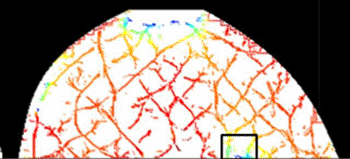Optical Mammography Effectively Diagnoses Breast Cancer
By MedImaging International staff writers
Posted on 10 Oct 2012
New optical imaging technology could provide clinicians with strategies to both identify breast cancer and track individual patients’ response to initial treatment of the disease. Posted on 10 Oct 2012
The noninvasive technology utilizes near infrared (NIR) light to scan breast tissue, and then applies an algorithm to interpret the data. Differences in light absorption allow identification of water, fats, and oxygen-rich and oxygen-poor tissue, the basic structures in breast tissue.

Image: Shown is an optical mammography image of hemoglobin oxygenation of a duct carcinoma in situ (DCIS), a breast cancer in the lining of the milk ducts that has not yet invaded nearby tissues. In this image, the boxed area corresponds to the cancer location and indicates lower values of hemoglobin oxygenation. For cancerous tissue that is associated with abnormal hemoglobin concentration and oxygenation, optical mammography can be used to help diagnose breast cancer and also indicate how well a patient responds to breast cancer chemotherapy (Photo courtesy of Tufts University Medical Center).
A five-year clinical study of the procedure, funded by a USD 3.5 million grant from the US National Institutes of Health (NIH; Bethesda, MD, USA), is now underway at Tufts University Medical Center (Boston, MA, USA).
“The consensus is that X-ray mammography is very good at detecting lesions but it’s not as good at determining which suspicious lesions are really cancer,” said professor of biomedical engineering Sergio Fantini, PhD, who is leading the research project. The Tufts NIR technique could complement traditional mammography, particularly for women younger than 40 who may have dense breast tissue that has a tendency to blur features in X-rays.
The NIR technique, because it does not employ ionizing radiation, can be applied multiple times over a short period without risk of radiation exposure, Dr. Fantini noted. Another benefit of the technology is that, dissimilar to other breast imaging modalities, it can gather functional real-time images of metabolic alterations, such as levels of hemoglobin concentration and oxygenation.
“It’s been reported that patients who respond to breast cancer chemotherapy show a decrease in hemoglobin and water concentration and an increase in lipid concentration at the cancer site,” explained Dr. Fantini. “This suggests that NIR imaging can be valuable not only in diagnosing breast cancer but in monitoring individual response to therapies without requiring repeated X-rays. For example, it could help determine if a patient is responding to neoadjuvant chemotherapy administered to shrink a tumor before surgery.”
Optical mammography is also more comfortable than standard mammograms. The patient’s breasts are only slightly compressed between two horizontal glass panels and then illuminated by NIR light. A specialized software program displays real-time images of the breast as the optical system scans back and forth. A light detector within the system displays the intensity of the NIR beam as it is transmitted through the breast.
By using an algorithm based on the optical data, the technology generates breast images utilizing the intensity of the transmitted light. The images are displayed automatically and can be read soon after the procedure, as is the case with X-ray mammograms. The technology can be fit into compact, portable, and handheld devices.
In collaboration with Roger Graham, MD, director of Tufts Medical Center’s Breast Health Center, and Marc Homer, MD, chief of mammography at Tufts Medical Center, Dr. Fantini and colleagues conducted proof of concept evaluations to see if their procedure could validate data gathered with X-rays on two patients who each had suspicious lesions in one of their breasts.
The optical imaging was effective in enabling the investigators to identify cancerous tissue. “The test results were compatible with what we found in the X-ray mammography,” Dr. Graham stated. “It was also painless for the patients and eliminated radiation exposure.”
The NIH-funded study will examine women with breast cancer, healthy women, and women with benign breast lesions in an effort to investigate the effectiveness of optical mammography in identifying breast cancer and differentiating between malignant and benign tumors. The study will also assess breast cancer patients who are undergoing chemotherapy in to clarify the ability of optical mammography to determine patient response at the beginning of therapeutic treatment.
Related Links:
Tufts University Medical Center














